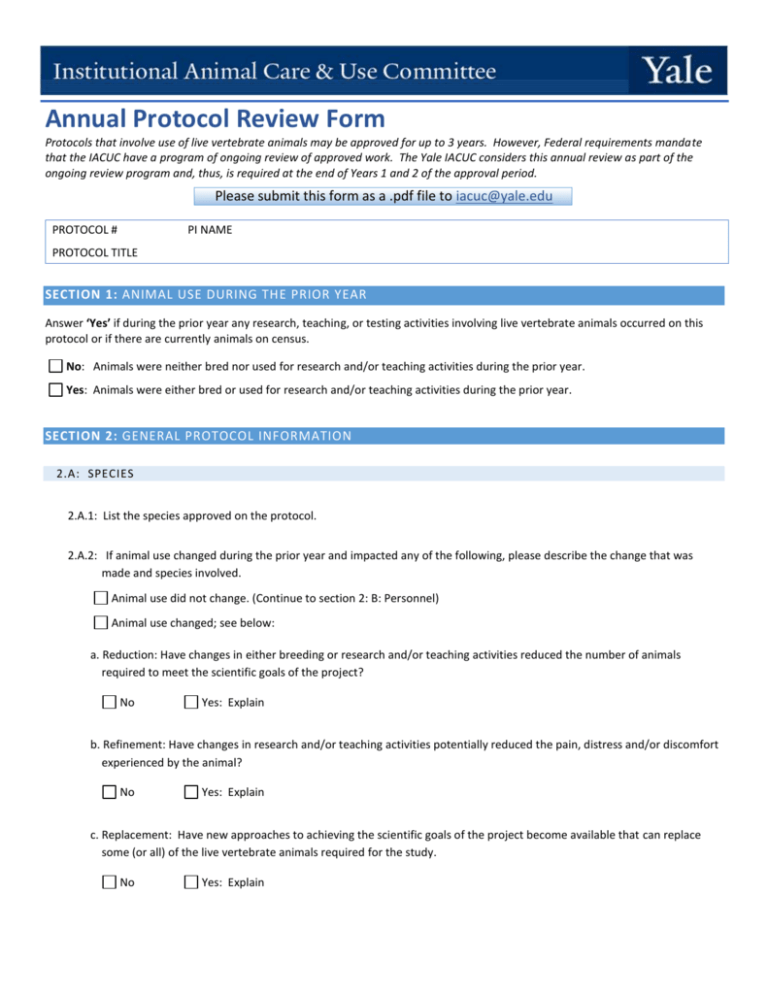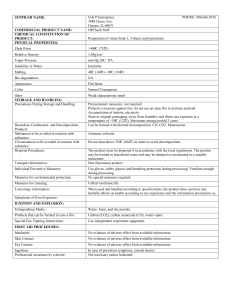Annual Protocol Review
advertisement

Annual Protocol Review Form Protocols that involve use of live vertebrate animals may be approved for up to 3 years. However, Federal requirements mandate that the IACUC have a program of ongoing review of approved work. The Yale IACUC considers this annual review as part of the ongoing review program and, thus, is required at the end of Years 1 and 2 of the approval period. Please submit this form as a .pdf file to iacuc@yale.edu PROTOCOL # PI NAME PROTOCOL TITLE SECTION 1: ANIMAL USE DURING THE PRIOR YEAR Answer ‘Yes’ if during the prior year any research, teaching, or testing activities involving live vertebrate animals occurred on this protocol or if there are currently animals on census. No: Animals were neither bred nor used for research and/or teaching activities during the prior year. Yes: Animals were either bred or used for research and/or teaching activities during the prior year. SECTION 2: GENERAL PROTOCOL INFORMATION 2.A: SPECIES 2.A.1: List the species approved on the protocol. 2.A.2: If animal use changed during the prior year and impacted any of the following, please describe the change that was made and species involved. Animal use did not change. (Continue to section 2: B: Personnel) Animal use changed; see below: a. Reduction: Have changes in either breeding or research and/or teaching activities reduced the number of animals required to meet the scientific goals of the project? No Yes: Explain b. Refinement: Have changes in research and/or teaching activities potentially reduced the pain, distress and/or discomfort experienced by the animal? No Yes: Explain c. Replacement: Have new approaches to achieving the scientific goals of the project become available that can replace some (or all) of the live vertebrate animals required for the study. No Yes: Explain 2.B: PERSONNEL Provide the names of personnel who should no longer be listed on the protocol, e.g., staff or post-doctoral fellows that left the lab during the past year. 2.C: CHANGES IN YOUR RESEARCH PROGRAM Reminder: IACUC approval is required prior to initiating new or revised experiments. Examples of new or revised use of an animal include, but are not limited to: Breeding or experiments performed using a new species Breeding or performing experiments on additional mouse lines/strains, irrespective of whether an increase in the approved number of animals is needed. Developing and/or using experimental models Administering additional experimental agents Performing new procedures or making changes to an already approved procedure Changing or using a new anesthetic, analgesic, euthanizing and/or other therapeutic agent regime Changing the Vendor or species used for custom antibody production SECTION 3: USE OF LIVE VERTEBRATE ANIMALS Complete the applicable section below (3A Laboratory Animals; 3B Animals from Native Environments) for the source of the live vertebrate animals used during the prior year for research, teaching or testing activities. 3.A: LABORATORY ANIMALS USED; I.E., WERE PURPOSE BRED FO R RESEARCH, TEACHING OR TES TING Check if this section is Not Applicable 3.A.1: ADVERSE EVENTS For each of the four types of unexpected and/or adverse events described below, if the response is “Yes”, your explanation should include both the species involved and a brief description of the event, how it was managed, and, if relevant, steps that will be/were taken to prevent a recurrence. a. Increases in pain or distress occurred or animals exhibited clinically signs of disease not otherwise described in the protocol No Yes, Explain: b. Unexpected death of animals or incidents involving the death of an animal that occurred prior to the intended study endpoint No Yes, Explain: c. Adverse event occur during the euthanasia procedure resulting in an increase in pain and/or distress to the animal No Yes, Explain: d. Genetically altered animals were produced that exhibited adverse clinical phenotypes No NA Yes: Address the following: i. Indicate the species and genotype of the genetically altered animal(s). ii. List the adverse phenotype(s) and indicate if you will continue to breed the animal line. If you will continue breeding the line, explain the value of continuing to generate progeny with the adverse phenotype. iii. If the phenotype adversely affects the health and/or welfare of the animal(s), describe how the health issues are being managed? Reminder: If a phenotype results in a clinically evident physical and/or behavioral abnormality and/or other presentation that could affect the animal’s welfare a Protocol Modification Request and possibly a Special Instruction Form must be submitted that: Describes the exhibited clinical sign(s) Provides a monitoring plan that includes the frequency of monitoring, which must increase commensurate with the development of clinical signs, a list of the parameters to be assessed at each monitoring session, a description of how clinical signs will be managed and criteria for removing an animal from the study and euthanizing it prior to the intended study endpoint. If a Special Instruction form is needed, it must provide clear instructions to YARC staff as to when the lab should be contacted when clinical signs are observed. 3.A.2: CLASS OF DRUGS Class of Drugs: If the protocol includes approval for the use of a class of non-hazardous, experimental agents, e.g. tracers, agonists, antagonists, etc., and such agents have been used during the prior year, complete the table below. Do not list therapeutic drugs (e.g., Ketamine/Xylazine, Isoflurane, Buprenorphine, Meloxicam). Species Drug Class Reagent/Drug Dose/Range If adverse events or unexpected physiological effects occurred, have you received approval to continue using the drug/reagent? NA Yes No NA Yes No NA Yes No NA Yes No NA Yes No NA Yes No Describe how the health and well-being of the animal was managed during the adverse event. 3.A.3: EXPECTED MORTALITY For protocols that include expected mortality, provide by species the number of deaths that occurred during the previous year in which an animal was not purposefully euthanized at the intended study endpoint, e.g., found deceased or euthanized for humane reasons prior to the intended study endpoint. For each death, indicate the cause (or suspected cause) of death and describe any changes to the experiment that were/will be made to reduce future morbidity and/or mortality. 3.A.4: PERMISSION TO HAVE CUSTOM ANTIBODIES MADE Do you plan on changing the Contract Laboratory that was named in your original protocol? No Yes: a. Which Contract Laboratory do you plan to use? b. If the Contract Laboratory that you plan to use is not on the IACUC’s List of Approved Contract Labs, please complete and submit with this Annual Review form the Custom Antibody Production Contract Laboratory Animal Use Agreement to request that the vendor be added to the Approve Contract Labs list. Reminder: If a species being used to make antibodies has changed, a Protocol Modification Request must be submitted to add the additional species to the protocol. 3.B: ANIMALS USED WERE ACQUIRED FROM OR USED IN THEIR NATIVE ENVIRON MENT, I.E., WILD/FERAL ANIMALS OR ANIMALS NOT OWNED BY YALE Check if this section is Not Applicable 3.B.1: NUMBER OF ANIMALS CAPTURED, ACQUIRED OR STUDIED Provide the number of each target species captured/acquired from or studied during the past year and the USDA pain Category under which the animal was used. If additional space is needed, please attach a list to this document. Species Number of Animals USDA Pain Category 3.B.2: PERMITS Have any of your permits been renewed during the last year? No Yes: Attach the current permit(s) to this Annual Review form. 3.B.3: ADVERSE EVENTS a. Did any unexpected or adverse events occur resulting in increased pain or distress to animals that were acquired? No Yes: Indicate the species involved and describe the situation, how it was managed and the steps taken to prevent a recurrence. b. Were any captured animals euthanized because of an unexpected adverse event or humane condition prior to the intended study endpoint? No Yes: Indicate the species/strain, how many animals were euthanized, the adverse event/humane condition that resulted in euthanizing the animals and the euthanasia method used. c. Were any animals captured unintentionally? No Yes: Indicate the species/strain(s) captured, how many were captured and how was the situation handled, i.e., what became of the animals? 3.B.4: EUTHANASIA Did unexpected adverse events occur during the euthanasia procedure resulting in increased pain and/or distress to an animal? No Yes: Indicate the species involved and describe how each situation was managed and what steps were taken to prevent a recurrence?






